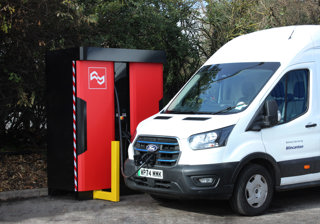This feature was taken from our Electric Fleet: Moving to Net Zero special report.

One of the enduring foundations of efficient fleet management is the mantra “right vehicle for the right job”.
While, traditionally, this mainly applies to vans, it is also increasingly being used when it comes to emerging new electric vehicle (EV) technologies such as drones and autonomous delivery robots.
Although their use cases are fairly specific due to the relatively light and small items they are able to carry, a number of organisations are finding huge benefits through them.
Drones, for example, are being used by police forces to search for missing persons and suspects, as well as monitor public safety events such as football matches. Network Rail uses them to inspect railway infrastructure, while a number of NHS Trusts are using them to carry medical supplies.
“Drone operations have the potential to transform how we deliver goods and provide services, particularly in less well-connected regions,” says Simon Masters, future flight challenge deputy director at UK Research and Innovation.
This Government department is working with the UK Civil Air Authority (CAA) to carry out a number of trials exploring the use of drones and how to safely integrate them in UK airspace.
One of these projects, which began last month, sees drones deliver blood samples from Guy’s Hospital to a laboratory at St Thomas’ Hospital, both in London, for patients undergoing surgery who are at high risk of complications from bleeding disorders.
Guy’s and St Thomas’ NHS Foundation Trust usually has these delivered by van and motorbike couriers, but this can take more than half-an-hour.
The drones, which can cruise at around 60mph at approximately 70m above ground level, take two minutes, enabling quicker analysis, helping to efficiently determine whether patients are safe to undergo surgery or be discharged.
The Wing drones being used in the trial are primarily made of foam, weigh around 5kg, are highly automated and operate along pre-programmed flight routes. All flights are overseen by a certified and trained pilot.
Medical logistics company Apian, which is a partner in this trial, has also already pioneered medical flights across the Solent and Northumberland in England and in Dublin.
Surveillance needs
Network Rail uses drones to help maintain the railway infrastructure, including track, bridges, tunnels and viaducts.
Its drones gather data, videos and images of the railway, including areas that are usually difficult to access, such as roofs, coastal areas and the overhead wires that power electric trains, to allow it to understand any issues and identify what repairs may be needed.
Network Rail also uses drones to spot leaves on the line, which can cause delays to its services.
“If we can find things quicker, we can fix things quicker, meaning we can keep our passengers and freight customers moving on time,” says Dom Mottram, programme manager for national drone strategy at Network Rail.
The surveillance aspect is also used by many police forces throughout the UK. One of the most recent to set up a specialist drone team – in 2022 – is Cheshire Constabulary.
In 2023, its drones took to the skies 1,576 times, being deployed to a variety of incidents and events, including missing persons, suspect searches, fatal collisions, cannabis cultivation (using thermal image cameras) and public safety events.
Over the year, the drone unit spent 292.5 hours patrolling the skies, flying more than 1,120 miles, searching more than 33,000 acres of land, locating 50 high-risk missing people and aiding the arrest of 216 offenders.
“Having drone capability makes a huge difference in the way we protect vulnerable people and gather critical evidence at scenes," says Sgt Darren Mundey, who leads the drone unit.
“Having the ability to use our drones provides a more cost-effective alternative to the National Police Air Service and increases our tactical options.”
In August, the CAA selected six more projects for trials, including those by Airspection to inspect offshore windfarms and Amazon Prime Air for consumer drone deliveries.
“Drones always capture the public imagination, but they have a specific and niche role,” says Tim Jones, director of marketing, communications and sustainability at courier company DPD.
“It is a technology that we’re looking at, but there are limitations on flight weight, tracking and regulations so I don't foresee drones either now or in the near future being a large volume solution for the delivery of parcels.”
Delivery robots
DPD, however, is already using another zero-emission electric delivery technology – autonomous robots.
It introduced its six-wheeled electric robots to Milton Keynes two years ago as a last-mile delivery solution, and so far these have travelled almost 500 miles and fulfilled more than 2,500 trips in residential areas.
DPD has now introduced the robots to a second depot, Warth Park on the western edge of Raunds in Northamptonshire, taking its fleet to 10.
It will roll out robot deliveries to 10 UK towns and cities within the next 12 months, potentially taking the number of robots to 50, with up to 30 depots nationwide identified as suitable locations.
“The whole point of the robots is to test the viability of the technology and see if it can supplement the number of deliveries that we do from one site,” says Jones.
“It's been a great way for us to deliver parcels to typically within a mile or so radius of the depot and we see it definitely being part of the future.”
Supermarket giant Co-op already operates Starship Technologies delivery robots in Bedford, Cambourne, Cambridge, Leeds, Rushden, Trafford, Wakefield and Wellingborough.
These robots are lightweight and travel at the speed of a pedestrian (no faster than 4mph).
They use a combination of sensors, artificial intelligence and machine-learning to travel on pavements and navigate around any obstacles, while computer vision-based navigation helps them map their environment to the nearest inch.
Starship says the average delivery uses only the same amount of energy as boiling a kettle for a cup of tea.
Together with Co-op, it has also announced the installation of its first European wireless charging station in Cambourne, which will allow the robots to recharge autonomously.
Starship says this will further reduce emissions in Cambourne as robots will no longer need to be couriered by van between service areas as they will take themselves to charge when they are low on energy.
“We know that the autonomous, quick and convenient delivery of groceries can reduce the number of short car journeys locally, and are pleased to see the introduction of wireless charging designed to further improve the energy efficiency of robot deliveries,” says Chris Conway, e-commerce director at Co-op.
Decarbonising a fleet is not just about replacing an ICE vehicle with a like-for-like electric replacement – it may open the door to other, more operationally efficient transport modes.
In our new Electric Fleet: Moving to Net Zero special report, we look at the fleets that are already utilising flying drones, rolling robots or powered mobility such as e-cargo bikes and light vehicles, assessing use cases and considerations for organisations looking to pilot these options.
We also look ahead to forthcoming battery electric technology to evaluate its potential impact on fleet operations, with longer ranges and faster charging among the key benefits, as well as the potential of hydrogen, which is undergoing a number of Government-funded trials in the UK.
Other topics we investigate include the ongoing impact of the ZEV Mandate and how fleet managers need to be prepared to take advantage of any potential deals offered by manufacturers, and technology trends – including batteries – which will have an influence on fleet operations.
We also look at what fully-electric cars will hit the UK market over the next 12 to 18 months, some of which will offer a WLTP range of more than 400 miles.






















Login to comment
Comments
No comments have been made yet.